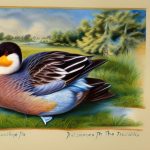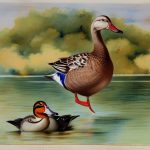Line breeding is a selective breeding method used to concentrate desirable traits within a population of animals, in this case, ducks. It involves breeding closely related individuals, such as siblings or cousins, in order to reinforce specific genetic traits. The goal of line breeding is to create a more uniform and predictable population of ducks with the desired characteristics, such as size, color, egg production, or temperament. By carefully selecting and mating ducks with the desired traits over several generations, breeders can establish a line of ducks that consistently exhibit those traits.
Line breeding differs from inbreeding in that it is a more controlled and strategic approach to breeding. While inbreeding can lead to an increase in genetic defects and health issues due to the concentration of harmful recessive genes, line breeding aims to minimize these risks by carefully selecting breeding stock and monitoring the genetic diversity within the population. It is important for breeders to have a thorough understanding of genetics and a clear breeding goal when implementing a line breeding program for ducks.
Key Takeaways
- Line breeding is a selective breeding technique that involves mating closely related individuals within a specific family line to concentrate desirable traits.
- Benefits of line breeding ducks include the ability to fix desired traits, improve uniformity, and maintain breed standards.
- Selecting breeding stock involves choosing individuals with desirable traits, good health, and genetic diversity to avoid inbreeding depression.
- Managing line breeding programs requires careful record-keeping, monitoring of genetic diversity, and periodic outcrossing to introduce new genetic material.
- Potential pitfalls of line breeding include the risk of inbreeding depression, loss of genetic diversity, and increased susceptibility to genetic disorders.
- Maintaining genetic diversity is crucial for the long-term health and viability of duck populations, and can be achieved through careful breeding practices and occasional outcrossing.
- In conclusion, line breeding can be a valuable tool for duck breeders, but it requires careful management to avoid potential pitfalls and maintain genetic diversity for future generations.
Benefits of Line Breeding Ducks
Line breeding offers several benefits for duck breeders looking to improve and maintain specific traits within their flocks. One of the main advantages is the ability to consistently produce ducks with the desired characteristics, whether it’s a certain color pattern, body size, or egg-laying ability. By selectively breeding closely related ducks that exhibit these traits, breeders can create a more uniform and predictable population that meets the standards of the breed.
Another benefit of line breeding ducks is the potential for genetic improvement over time. Through careful selection and mating of ducks with the desired traits, breeders can gradually enhance the overall quality of their flock. This can lead to improved productivity, such as increased egg production or better meat quality, as well as a more visually appealing and standardized appearance. Additionally, line breeding can help preserve rare or unique genetic traits within a specific duck breed, contributing to the conservation and diversity of domestic duck populations.
Selecting Breeding Stock
When implementing a line breeding program for ducks, selecting the right breeding stock is crucial to the success of the program. Breeders should start with high-quality ducks that exhibit the desired traits they wish to reinforce within their flock. This may involve evaluating individual ducks for specific characteristics such as body conformation, feather color and pattern, egg production, or temperament. It’s important to choose ducks that not only meet the breed standards but also possess strong genetic potential for passing on these traits to their offspring.
In addition to physical traits, breeders should also consider the genetic background and health history of potential breeding stock. Ducks with a known lineage of strong and healthy individuals are more likely to contribute positively to the line breeding program. It’s also important to assess the genetic diversity within the population and avoid selecting ducks that are closely related or have known genetic defects. By carefully evaluating and selecting breeding stock, breeders can lay a solid foundation for their line breeding program and increase the likelihood of producing high-quality offspring.
Managing Line Breeding Programs
Managing a line breeding program for ducks requires careful planning and record-keeping to track the genetic progress and maintain the desired traits within the population. Breeders should establish clear breeding goals and criteria for selecting mating pairs based on the specific traits they aim to reinforce. This may involve creating a breeding plan that outlines which ducks will be mated together in each generation to achieve the desired genetic outcomes.
In addition to strategic mating decisions, managing a line breeding program also involves monitoring the genetic diversity within the population to avoid potential pitfalls such as inbreeding depression. Breeders should keep detailed records of each duck’s lineage and genetic background to track relatedness and identify potential risks of genetic defects. By maintaining accurate records and periodically assessing the genetic diversity, breeders can make informed decisions about which ducks to include in their breeding program and when to introduce new genetic material from outside sources.
Potential Pitfalls of Line Breeding
While line breeding offers several benefits for duck breeders, there are also potential pitfalls that must be carefully managed to avoid negative genetic outcomes. One of the main risks associated with line breeding is the potential for inbreeding depression, which occurs when closely related individuals are mated together, leading to an increase in harmful recessive genes and genetic defects within the population. To mitigate this risk, breeders must carefully monitor the genetic diversity within their flock and avoid mating ducks that are too closely related.
Another potential pitfall of line breeding is the loss of genetic diversity within the population over time. By consistently selecting and mating ducks with specific traits, breeders may inadvertently reduce the overall genetic variability within their flock. This can lead to a decrease in adaptability and resilience to environmental changes or disease outbreaks. To address this issue, breeders should periodically introduce new genetic material from outside sources to maintain genetic diversity and prevent the negative effects of genetic bottlenecking.
Maintaining Genetic Diversity

Maintaining genetic diversity is essential for the long-term success and sustainability of line breeding programs for ducks. To preserve genetic variability within the population, breeders should periodically introduce new genetic material from unrelated individuals or outside sources. This can help prevent the negative effects of inbreeding depression and genetic bottlenecking, as well as improve the overall adaptability and resilience of the duck population.
In addition to introducing new genetic material, breeders can also implement strategies such as rotational crossbreeding or outcrossing to increase genetic diversity within their flock. These methods involve mating ducks from different lines or breeds to introduce new genetic combinations and reduce the risk of harmful recessive genes becoming concentrated within the population. By actively managing genetic diversity within their line breeding program, breeders can help ensure the long-term health and viability of their duck population.
Conclusion and Future Considerations
In conclusion, line breeding offers several benefits for duck breeders looking to improve and maintain specific traits within their flocks. By selectively breeding closely related individuals with desirable characteristics, breeders can create a more uniform and predictable population of ducks while preserving rare or unique genetic traits within a specific breed. However, it’s important for breeders to carefully select breeding stock, manage their line breeding program effectively, and maintain genetic diversity to avoid potential pitfalls such as inbreeding depression and loss of genetic variability.
Looking ahead, future considerations for line breeding programs may involve incorporating advanced genetic technologies such as DNA testing and genomic selection to enhance the accuracy and efficiency of trait selection. Additionally, collaboration between duck breeders and conservation organizations can help promote the preservation of rare or endangered duck breeds through strategic line breeding efforts. By continuing to refine and innovate line breeding practices, duck breeders can contribute to the long-term sustainability and diversity of domestic duck populations while meeting the evolving needs of consumers and agricultural markets.
If you’re interested in line breeding ducks, you may also want to check out this informative article on creating an A-frame chicken coop from PoultryWizard. It provides valuable insights into designing a functional and comfortable living space for your poultry, which can be beneficial for ducks as well.
FAQs
What is line breeding in ducks?
Line breeding in ducks is a breeding strategy where closely related ducks within the same family line are bred together to maintain or enhance specific desirable traits. This can include traits such as size, color, egg production, and temperament.
What are the benefits of line breeding ducks?
Line breeding can help to fix desirable traits within a duck population, leading to more consistent and predictable offspring. It can also help to maintain genetic diversity within a specific line of ducks.
What are the potential drawbacks of line breeding ducks?
Line breeding can also lead to an increased risk of genetic defects and health issues due to the concentration of certain genes within the population. It is important to carefully manage line breeding to minimize these risks.
How can line breeding be managed to minimize risks?
To minimize the risks associated with line breeding, it is important to carefully select breeding stock, monitor the health and genetic diversity of the population, and occasionally introduce new genetic material from outside the line to maintain diversity.
What are some common traits that breeders may focus on when line breeding ducks?
Breeders may focus on traits such as size, color, plumage patterns, egg production, and temperament when line breeding ducks. These traits can vary depending on the specific goals of the breeder and the intended purpose of the ducks (e.g., meat production, egg production, exhibition, etc.).
Meet Walter, the feathered-friend fanatic of Florida! Nestled in the sunshine state, Walter struts through life with his feathered companions, clucking his way to happiness. With a coop that’s fancier than a five-star hotel, he’s the Don Juan of the chicken world. When he’s not teaching his hens to do the cha-cha, you’ll find him in a heated debate with his prized rooster, Sir Clucks-a-Lot. Walter’s poultry passion is no yolk; he’s the sunny-side-up guy you never knew you needed in your flock of friends!







